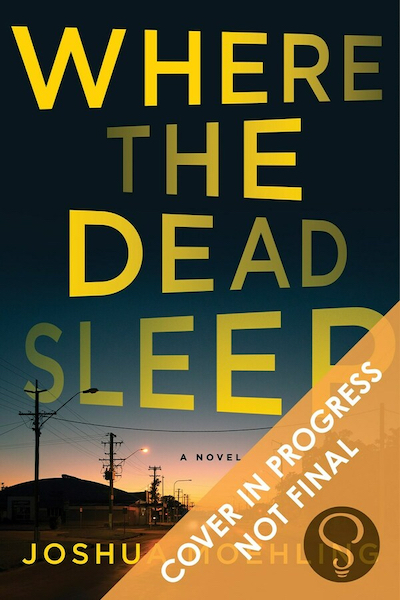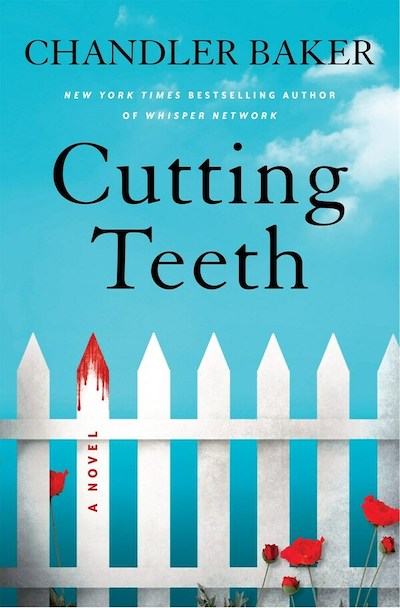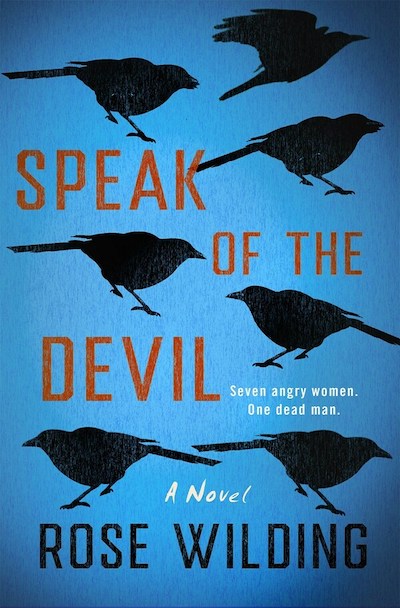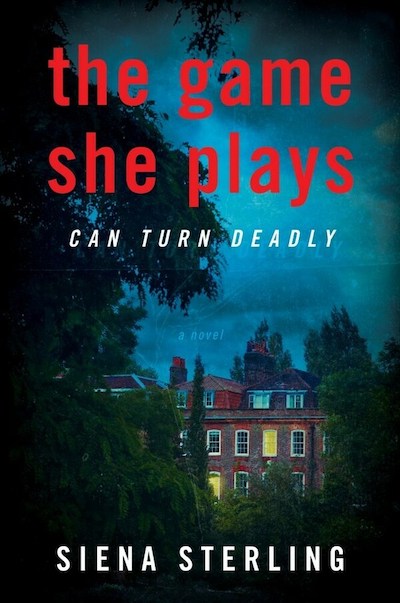Lukas Landon is a former war correspondent, with multiple deployments in both Iraq and Afghanistan. He’s seen plenty of dangerous situations, but being trapped on the ocean floor in an upside-down shrimp trawler, with the water rising and oxygen depleting, beats anything he’s experienced. Landon is living on the boat while writing a feature on the crew of the Philomena, which went down during a freak storm.
The novel jumps among Landon’s attempts to survive his water soaked prison, reflections on his military experiences, retelling of his failed marriage, and, most compelling of all, interviews with the crew of the Philomena. These include Captain Clarita Esteban, an ex-sergeant and Black woman trying to make it in a white man’s world. A first mate who came to Florida during the Mariel boatlift. And a Haitian-born cook with a wealth of knowledge far beyond traditional medicine.
But as far as we may wander, Sites pulls us back to Landon locked in that trawler, the clock ticking. Will he survive? And will he ever find the forgiveness he so desperately craves.A unique, taut read by the author of the nonfiction The Things They Cannot Say that illustrates the impact of trauma and the hope for redemption.
Thrillers
DC resident Helen Warwick is ready for the quiet life now that she’s retired. Her frequent, moments-notice travel as a state-department trade specialist all but ended her marriage, and her grown children have had it, too. What they don’t know is that Helen (like author Dees) was actually a CIA operative, and all those times she was absent were because she was involved in “wet work”—killings—rather than diplomacy.
Helen is determined to put it all right and win her family back. But when she arrives at her son’s house to babysit his dog, her plan goes up in gun smoke as the windows are shot in and, oops!, she’s forced to kill intruders who themselves seem like trained killers. The unique habitat that is DC comes to life here as Helen tries to figure out who’s after her, or who else the killers may have been targeting—perhaps there’s another family member with a clandestine background?
At the same time, she’s drawn into investigating a separate case that her lawyer-son asks for her smarts on—that of the DaVinci killer, who emulates artworks with the bodies he sadistically kills (there is one VERY gory scene here). The pages fly by as Helen dashes through family spats and deadly maneuvers toward and away from killers, while enduring realistic turmoil regarding her exasperated family.
Look forward to more from this engaging, still-got-it character! This, the first in a series, ends on a cliffhanger; it will also be a TV series starring Sharon Stone.
It’s the early months of the pandemic, and Kelly Doyle—who has recently moved to Philadelphia to live with her fiancé—finds herself with few friends and no job. But when her spouse-to-be calls off their wedding, Kelly hits a new level of despair. Her one bright spot is her childhood friend Sabrina; the two recently renewed their friendship thanks to the socials.
Sabrina has it all: a career as a best-selling romance author, a Virginia mansion right out of Elle Decor, and a handsome albeit hyper-masculine husband. So when Sabrina invites Kelly to move in with them—yes, it’s a little weird—Kelly is desperate enough to say yes. Before you can say “throuple” (why wasn’t that the Oxford English Dictionary’s word of the year?) the three are in bed together—this ain’t no cozy—and quickly establish a threesome. Until Kelly comes across the naked photos of another woman, who could well be her doppelganger, and learns that she is a former lover of the couple who has mysteriously vanished. Will Kelly be next?
A sexy read in which no one is right, no one is wrong, and everyone is lying. By the author of We Were Never Here, this is the ultimate summer read.
In this second in the series, Assistant Sheriff Ben Packard is juggling two major incidents. One is the death of his mentor, Sheriff Stan Shaw, which raises the question of whether Ben should run to replace Shaw as Sheriff of Minnesota’s Sandy Lake County, several hours north of the Twin Cities and a popular vacation spot. For someone who’s lived in the county for only a year or so, Ben’s got plenty of supporters, but he isn’t sure he’s ready to give up being a detective. Plus, he’s anxious about how being gay is going to play out at the polls. The other incident is the death of Bill Sanderson, shot multiple times in his bed. Nobody loved Bill—except maybe his ex-wife, who’s the sister of his new widow—but nobody seemed to hate Bill enough to actually kill him. Not his business partner, not his gambling buddies, not his spouse. To solve Bill’s death, Ben goes even deeper into the Sandy Lake community than ever before, peeling off the many dark and gritty layers, deciphering the complex family relations, and at one point putting his own life at risk. This novel works fine as a stand-alone, but readers of the first in the series, And There He Kept Her, will appreciate seeing Ben’s development and piecing together the disquieting world of Sandy Lake.
I had a moment of “yuuuuup” when I read that Baker’s debut adult novel, Whisper Network, was chosen as a Reese’s Book Club Pick, because more than one of the characters here strongly telegraphs “unhinged woman played by Reese Witherspoon.” The women are uber-mothers at the martyrdom competition that is a private preschool. Everyone’s life is perfect, thank you, no sacrifice is too great, and the mom committee has everything very much under tight control. There is one problem. The four-year-olds like to bite. Not little bites, either. Their parents and siblings are the victims of vicious, prolonged attacks that draw copious blood that the biters seem to enjoy swallowing. Then their teacher is found dead outside the classroom, with a pool of blood surrounding her that has little footprints in it. Everyone knows that their child didn’t do it, but Ms. Ollie is dead, and the investigation is on. This book is at times as funny as it is strange, with Baker hilariously skewering modern parenthood and its obsessions, while also giving us behind-the-plastic-smiles looks at parents’ inner thoughts. (I think we can all agree that “just a month or two break from giving a shit” isn’t much to ask for). Did you like Big Little Lies? This one’s for you.
Celebrity books are hit and miss. It often seems like they hired a ghost writer, and worse again is when you wonder why they didn’t. But this crime-fiction debut, the first in a series by former FBI Director and October-surprise specialist Comey, is firmly in the hit category. Comey draws on his decades of experience to show the hectic activity behind the big-name trials that appear in New York State Supreme Court, the imposing steps of which we’ve all seen on the news. Two interrelated cases, and two teams of lawyers and investigators, are his focus: the trial for the murder of a former philandering Governor of New York, Tony Burke, and another murder case, one that features possible mafia violence and intimidation. A feeling of danger is introduced by Comey, a long-time mob prosecutor, with the lawyers maintaining a psychological operation as they massage the egos of mafiosi to encourage them to cooperate while keeping them alive. We also get a sense of a clock ticking ever more ominously as a fair outcome in one trial depends on the other one finishing first, with the justice system anything but swift. The layers of New York society are also well displayed here, from the ”fucking rich people” loathed by Burke’s long-suffering Central Park West doorman to striving single-mom Assistant U.S. Attorney Nora Carleton—more of her in the next book, please!–whose Jersey home is far in every way from the Upper West Side. An engrossing look at a longtime prosecutor’s world and its pain and triumphs.
Hella Mauzer, 29, is both very much of Finland—she’s a dour private investigator who seems made from her country’s six-months of darkness —but completely not what her fellow 1950s Finns want her to be. Put flowers under your pillow on midsummer night and you’ll dream of your future fiancé, they hint, with marriage and motherhood then all but guaranteed. Hella wants none of it. She keeps both her ex-boyfriend, who can’t grasp that things are over, and her new, interested neighbor at arm’s length while immersed in two investigations. One is a favor to her father’s former secret-police colleague: a background check on the prospective head of Helsinki’s homicide squad. The other is more personal. Hella is desperate to find out who killed her parents, sister, and nephew, all of whom died when hit by a truck when Hella was a teen. Getting the courage to read the police file on her family’s deaths is a big step, and one that immediately leads her to suspect that there was much more to the tragedy than an accident. The background check is far from straightforward either, adding up to a tale that brings to mind Game of Thrones, with all that story’s evil and power-hungry machinations. If Scandinavian mysteries are your thing, try this, as well as Ann-Helén Laestadius’s Stolen, and Joachim B. Schmidt’s Kalman for great stories that take place outside the more common urban settings in Sweden and Denmark.
Jamie Spellman is dead and nobody’s sorry. The women in his life are not only fine with the loss, we find eight of them sitting in a disused room above a Manchester pub with Jamie’s head on the table before them, a smell of “rot and pennies” in the air. One of them probably did the gruesome deed, but it’s hard to tell who when the story of each woman’s awful interactions with loathsome Jamie gets underway. It could have been his wife, Sadia; god knows he treated her badly enough. But Kaysha, the journalist investigating the story, knows that even though it’s always the spouse, the other women had equally valid reasons to hasten Jamie’s end. Another possibility is the teenager he was stringing along. Or maybe the mother who’s lost a daughter thanks to Jamie. Everyone’s got a story, and as they unspool, a lot is squeezed in, from infertility to alcoholism and from anger-fueled affairs to vicious gaslighting. It all comes together to link the women, whose stories converge in a way that will appeal to Kate Atkinson’s readers, and to create an ending that brings us back to that head on the table, but in a twisting, unexpected way. This debut author is one to watch.
Heading to Paris for a much-needed vacation after a bad break-up, Nicola Harris meets Englishman James Shuttleworth on the flight and the two fall madly in love. They vacation in the south of France and move to his flat in London, while Nicola practically forgets about her life back in Buffalo. And why not, when they probably have ten feet of snow to shovel? All is going swimmingly until James suggests they spend the weekend at a house party, complete with shooting pheasants and lots of Barbour, where Nicola will finally have a chance to meet his friends. The book is set in 1980, so we don’t yet have the term social anxiety, but that’s exactly what Nicola is experiencing. And rightfully so. This lot of private-schooled, Cambridge-educated, alcoholic aristocrats, with their insider language and weird nicknames, is terrifying. Nicola gives it the old college try—she does love James—but just when she thinks she’s broken through, Juliet arrives. James’ ex-fiancée. Beautiful and seductive. And a genius at undermining Nicola, especially when no one else is around. But what Juliet’s after may be far greater than just destroying Nicola, and we slowly come to realize that everyone is in danger from Juliet. A slow simmer that’s full of great characterization, this should appeal to fans of Lucy Foley and Ruth Ware.
A wonderfully constructed thriller with several narratives, ranging from the 1st century to the present, that eventually come together in the most satisfying of ways. At the outset we have a newly elected pope who has created havoc within the Church with his appointment of a nun, Elisabetta Celestino, as his secretary of state. At the same time, a strip of ancient papyrus that comes from the long-lost Gospel of Mary Magdalene is discovered in a Cairo museum; just a snippet, it still manages to contain shocking information about the role of women in the early Church. It’s stolen and sold to a powerful, conservative U.S. billionaire—and collector of early Christian writings—who wants nothing more than to suppress the content. Alternating with the present-day narratives is the story of Mary Magdalene herself as we follow her from Jerusalem to Egypt to Ancient Rome. At the book’s center is Harvard Divinity School professor Cal Donovan, the protagonist of several of Cooper’s novels, the lynch pin who connects all the narratives. Often thrillers with historical backgrounds like this get weighed down with too much information and overly elaborate plots. But readers will move through this book like a hot knife through butter. For fans of Dan Brown and Steve Berry.










